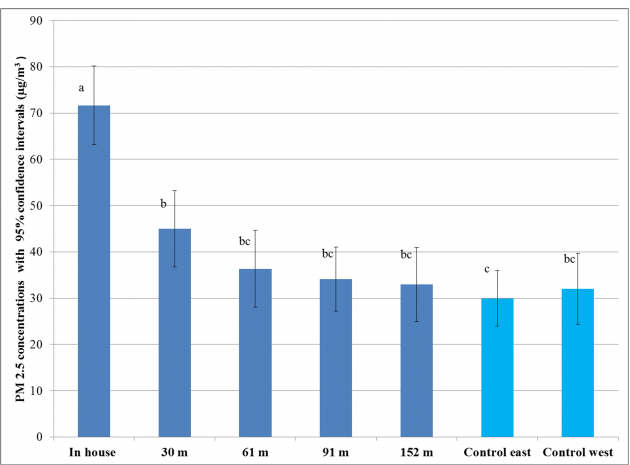![]() Waste to Worth home | More proceedings….
Waste to Worth home | More proceedings….
Abstract
Air emissions from animal feeding operations have become a growing concern for producers and their neighbors. Much work has been done to quantify emission rates; however, little information has been provided about air quality downwind from these facilities. This study investigates PM2.5 (particulate matter ≤ 2.5 µm in diameter) levels as they dissipate from the exhaust fans of selected commercial, tunnel-ventilated, broiler houses in Northeast Georgia. PM2.5 was measured in real time using aerosol monitors and from a time-integrated basis using cyclone samplers. Data were taken over the last 4-weeks of a summer flock (considered a worst-case-scenario) and filtered to insure enough data was present at each distance and time. Results indicate a rapid reduction in fine particulate concentration as the distance from the source increases. When compared to nearby monitoring data, particulate levels appear to be near background levels at distances greater than 30 m (100 ft) from the exhaust fans.
Why Study PM 2.5 in Poultry Production?
Considerable work has been done on evaluation of particulate and ammonia concentrations inside poultry houses and emissions from those houses. Less is known about how concentrations dissipate as they leave the houses. This is a concern for neighbors of production facilities as well as farm owners. The objective of this study was to investigate PM2.5 concentrations in the air up to 152.5 m (500ft) away from tunnel-ventilated broiler houses and compare those levels to ambient conditions.
What Did We Do?
The study was conducted on a four-house commercial broiler farm in Northeast Georgia, from July 18 through August 12, 2007. The houses were orientated east to west with open pasture located on the east end (downwind) of the four houses. The investigation incorporated a study design to include conditions which favored maximum emission rates, including high temperatures (July, August) and sampling during the final four weeks of the 8-week broiler grow-out cycle.
Real time (DustTrak 8520) and daily cumulative gravimetric (Triplex cyclone; BGI, model SCC 1.062) PM2.5 measurements were measured at locations as shown on Figure 1. Publicly available data taken by Georgia EPD [9] using a TEOM 1400ab sampler at a site in Athens, GA (approx.. 32 km east of the site) was also used as an additional “control site.”
What Have We Learned?
Particulate levels near poultry houses are elevated by emissions from the houses, however if we compare the readings on Figures 2a and 2b, we see that the largest single influence on the results was ambient conditions. The downwind levels (2b) closely followed the ambient levels (2a). Similar results were seen for the daily gravimetric readings. If we look at the average readings for the entire experiment at each distance from the house and compare those to in-house and ambient readings (Figure 3) we see a rapidly dropping influence on atmospheric particulate readings with no significant difference beyond 30 m from the houses. While some of the measurements were above EPA’s ambient air standards, ambient conditions were also above the standards during those days.
|
Figure 2 PM 2.5 levels vs. distance from houses |
Authors
John W Worley, Associate Professor, Poultry Science Department, University of Georgia jworley@uga.edu
Casey W Ritz1 Professor, Michael Czarick1,Sr. Public Service Associate, Brian D Fairchild1,Associate Professor, Luke P Naeher2 Associate Professor
1 Poultry Science Department, University of Georgia
2 Environmental Health Science, University of Georgia
Acknowledgements
The authors would like to acknowledge the contributions of Mr. Benjamin Hale and Mr. Adam Gray who did much of the field work including instrument calibration and lab analysis for this project and to Mr. Olorunfemi Adetona for his help in pulling together information for the document. We would also like to thank the US Poultry and Egg Association for their financial support that enabled this research to be accomplished.
The authors are solely responsible for the content of these proceedings. The technical information does not necessarily reflect the official position of the sponsoring agencies or institutions represented by planning committee members, and inclusion and distribution herein does not constitute an endorsement of views expressed by the same. Printed materials included herein are not refereed publications. Citations should appear as follows. EXAMPLE: Authors. 2013. Title of presentation. Waste to Worth: Spreading Science and Solutions. Denver, CO. April 1-5, 2013. URL of this page. Accessed on: today’s date.


